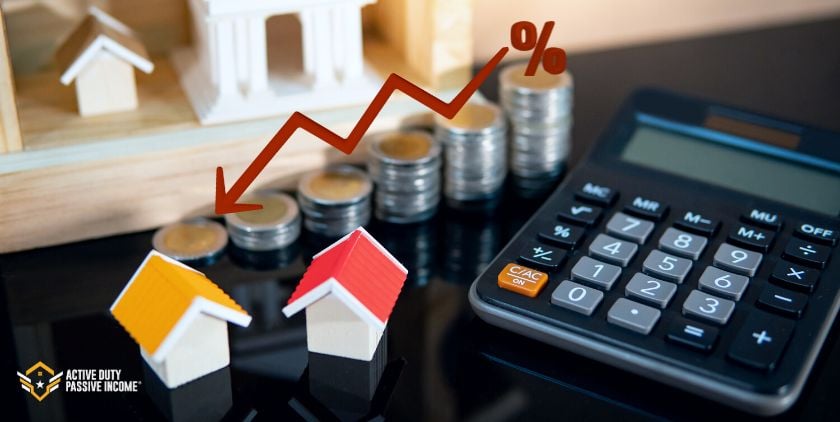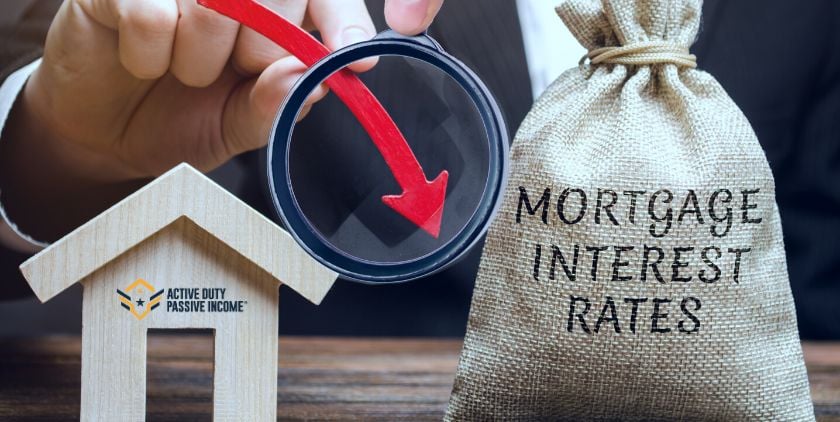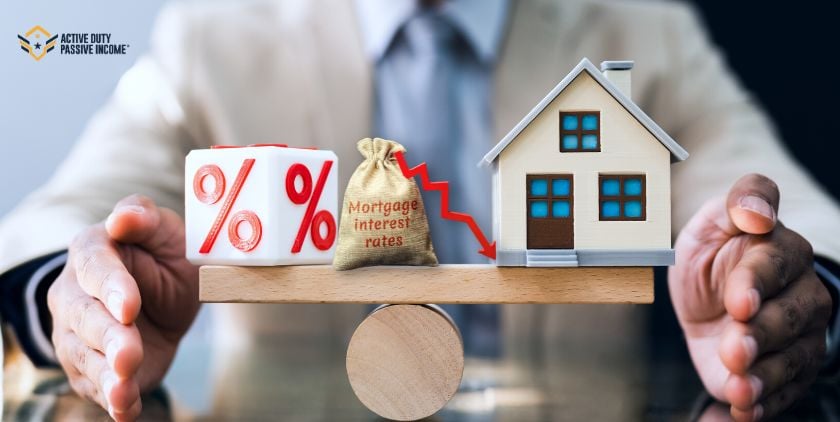Today, we’re delving into the world of home financing, focusing specifically on a mortgage option that might just offer the flexibility you’ve been looking for: the 2/1 Buydown. As military personnel, you face unique circumstances, frequent relocations being one, and we understand that financial flexibility is paramount in your housing decisions. A 2/1 Buydown can potentially provide that flexibility, reducing your interest rate and, consequently, your mortgage payments for the first two years of the loan.
The 2/1 Buydown mortgage is a tool that reduces the interest rate over the first two years of the loan before settling into a more standard rate for the remainder of the loan term. This reduction can significantly lower your initial monthly payments, providing financial breathing room in the early years of home ownership when it may be most needed. This blog post will walk you through the ins and outs of the 2/1 Buydown, explaining how it works, the pros and cons, and why it might be an advantageous option for military investors like you. Let’s dive in and demystify this mortgage option together.
What is a 2-1 Buydown?
A 2/1 Buydown is a mortgage option that lowers the interest rate, and hence monthly payments, for the first two years of the loan, achieved by making an upfront payment. This ‘buydown’ first reduces the rate by a substantial amount in the first year, and slightly less in the second, before reverting to the agreed rate. Beneficial to borrowers needing lower initial payments or expecting future income rise, the upfront cost is usually calculated from the rate difference. Details, like the reduced rate duration and upfront payment amount, depend on the lender and borrower negotiations.

How 2-1 Buydowns Work
A 2/1 Buydown works by allowing borrowers to reduce their mortgage interest rate and monthly payments for the initial years of their loan term. Here’s a step-by-step breakdown:
- Initial Interest Rate: The borrower starts with an original interest rate specified in the loan agreement. This is the rate that would apply if no buydown was chosen.
- Upfront Payment: The borrower makes an upfront payment to the lender, typically expressed as a percentage of the loan amount. This payment is used to “buy down” the interest rate for a specified period.
- Reduced Rate Period: The buydown period usually spans the first two years of the loan. During this time, the borrower enjoys a lower interest rate than the original rate. The reduced rate is typically calculated based on the difference between the original rate and the reduced rate for each of the two years.
- Year 1: In the first year of the buydown, the borrower pays the reduced interest rate, resulting in lower monthly mortgage payments compared to the original rate. The specific reduced rate for the first year is determined by the terms agreed upon during the buydown process.
- Year 2: In the second year, the borrower continues to benefit from the reduced rate, which is typically slightly higher than the first year’s reduced rate. The monthly payments remain lower than the original rate but may be slightly higher than those of the first year.
- Return to Original Rate: After the buydown period ends (usually two years), the interest rate returns to the original rate specified in the loan agreement. From that point onwards, the borrower makes monthly payments based on the original rate for the remaining term of the loan.
It’s important to note that the specifics of a 2/1 Buydown, such as the duration of the buydown period and the amount of upfront payment required, can vary depending on the lender and the terms negotiated between the borrower and the lender.
2-1 Buydown Pros and Cons
Pros:
- Lower Initial Payments: The primary benefit of a 2/1 Buydown is that it allows borrowers to have lower monthly mortgage payments during the initial years of the loan. This can be particularly helpful for individuals who have tight budgets or anticipate an increase in their income in the future.
- Financial Flexibility: The reduced payments in the early years provide borrowers with greater financial flexibility. They can allocate the saved funds towards other financial goals, such as paying off debt, saving for emergencies, or investing in home improvements.
- Easier Qualification: A 2/1 Buydown can make it easier for borrowers to qualify for a mortgage as the reduced initial payments may help meet the debt-to-income ratio requirements imposed by lenders.
Cons:
- Upfront Costs: Borrowers opting for a 2/1 Buydown are required to make an upfront payment to buy down the interest rate. This payment can be a significant amount, which may pose a financial burden or require additional savings.
- Temporary Reduction: The reduced interest rate and monthly payments are only temporary during the buydown period. Once the buydown period ends, the interest rate returns to the original rate specified in the loan agreement, and the monthly payments increase accordingly.
- Potential Long-Term Cost: Over the course of the entire loan term, the total interest paid may be higher compared to a mortgage without a buydown, as the original rate applies for the majority of the loan duration.
- Limited Availability: Not all lenders offer 2/1 Buydowns, so the availability of this option may be limited. Borrowers may need to research and shop around to find lenders who provide this financing option.
It’s crucial for borrowers to carefully evaluate their financial situation, future income prospects, and long-term goals before opting for a 2/1 Buydown. Consulting with a mortgage professional can provide further insight and guidance to determine if this option aligns with their needs and objectives.
When to Use a 2-1 Buydown
Here are some scenarios where a 2/1 Buydown can be beneficial:
- Lower Initial Budget: If you are purchasing a home or refinancing your mortgage and your budget is tight initially, a 2/1 Buydown can help reduce your monthly payments, making them more affordable during the early years.
- Future Income Increase: If you anticipate a significant increase in your income in the near future, such as a promotion, career change, or completion of education, a 2/1 Buydown can provide temporary relief during the lower-income period.
- Cash Flow Management: If you have other financial goals or obligations, such as paying off high-interest debt or saving for emergencies or home improvements, a 2/1 Buydown can free up some cash flow in the early years, allowing you to allocate funds to those priorities.
On the other hand, there are instances when a 2/1 Buydown may not be the best option:
- Short-Term Ownership: If you plan to sell the property or refinance within a couple of years, the benefits of the buydown may not outweigh the upfront costs. It’s important to assess whether the potential savings during the reduced rate period justify the initial payment.
- Strong Financial Position: If you have a stable and comfortable financial situation with no immediate budget constraints, a 2/1 Buydown may not be necessary. You can opt for a traditional mortgage without the buydown and potentially save on the upfront payment.
- Long-Term Ownership: If you plan to stay in the property for an extended period, the total interest paid over the entire loan term may be higher with a 2/1 Buydown compared to a standard mortgage. Assessing the long-term cost implications is crucial in such cases.
Your Home Isn’t Selling
If your home isn’t selling and you have opted for a 2/1 Buydown, it can impact your financial situation in a couple of ways:
- Extended Buydown Period: If your home isn’t selling within the initial buydown period (usually two years), you may be faced with the challenge of continuing to make lower monthly payments even though the benefits of the reduced rate were intended for the early years. This can result in a longer duration of reduced payments than initially anticipated.
- Financial Strain: If your home isn’t selling and you’re stuck with the reduced payments of the buydown, it may put a strain on your finances. The reduced payments were designed to provide temporary relief, assuming that the home would sell within a reasonable timeframe. However, if the home remains unsold, you might have to manage your budget more carefully to accommodate the ongoing lower payments.
If you are experiencing difficulty selling your home, it may be worth reassessing your overall selling strategy. Adjusting the listing price, improving the home’s appeal, or reevaluating your marketing efforts can help increase the chances of selling your home and potentially alleviate any challenges associated with the 2/1 Buydown.
It’s advisable to review your agreement and consult with your lender to understand any potential options or solutions available to you in case your home doesn’t sell within the intended time frame.
You’re Eyeing a Larger Home
If you’re eyeing a larger home and contemplating a 2/1 buydown, consider these factors:
- Affordability: A larger home means a bigger price tag and potentially heftier monthly payments. Ensure these align with your financial capability. The 2/1 buydown provides short-term relief by reducing initial payments.
- Buydown structure: In a 2/1 buydown, interest rates drop by 2% and 1% in the first and second years respectively. Despite this reduction, the increase in loan amount for a larger home may still result in higher payments than with a smaller property.
- Long-term implications: Post the initial two-year period, the interest rate reverts to the original, causing a spike in payments. Ensure future income and expenses can accommodate this.
- Refinancing options: If a larger home could stretch your budget, consider refinancing post-buydown to adjust loan terms. However, weigh this against the potential additional costs.
Buying a larger home could inflate your loan amount and monthly payments despite the 2/1 buydown’s reduced interest rate. Assess your financial health, budget, and long-term plans thoroughly, and consult a mortgage professional for personalized advice.
How do I qualify for a 2-1 buydown loan?
Qualifying for a 2/1 buydown loan is similar to qualifying for a traditional mortgage, but there may be additional criteria specific to the buydown program. Here are some general factors that lenders typically consider when evaluating your eligibility:
- Income and employment: Lenders will assess your income stability and your ability to make monthly payments. They will likely request documentation such as pay stubs, tax returns, and employment verification.
- Credit history: Your credit history and credit score are crucial factors in the mortgage approval process. Lenders will review your credit report to evaluate your payment history, outstanding debts, and credit utilization. A higher credit score generally improves your chances of qualifying for favorable loan terms.
- Debt-to-income ratio (DTI): Lenders analyze your DTI, which compares your monthly debt obligations to your gross monthly income. A lower DTI indicates a stronger financial position and makes you more likely to qualify for a mortgage. Different lenders may have varying maximum DTI requirements, but generally, a DTI of 43% or lower is preferred.
- Down payment: The down payment amount is an important consideration for lenders. While specific requirements can vary, having a larger down payment can improve your chances of qualifying for a loan and potentially help you secure more favorable terms.
- Property appraisal: The property you intend to purchase will undergo an appraisal to determine its value. The appraisal ensures that the loan amount aligns with the property’s worth and protects both you and the lender.
- Other factors: Lenders may consider other factors such as your savings and assets, employment history, and any outstanding liabilities.
It’s worth noting that eligibility requirements can vary between lenders and different buydown programs. It’s recommended to contact multiple lenders, mortgage brokers, or financial institutions to inquire about their specific criteria and available buydown options. They can provide you with detailed information and guide you through the application process, helping you determine if you qualify for a 2/1 buydown loan.
Comparing Seller Concession Options
Seller concessions in real estate transactions are financial aids offered by sellers to entice buyers, often covering closing costs or other purchase-related expenses. These concessions vary, including sale price reduction, closing cost coverage, or credits for repairs. It is quite common for the 2/1 buydown to be offered as a Seller concession. Here’s how it compares to other options:
- Closing Cost Coverage: Sellers covering some or all closing costs reduces immediate financial outlay for buyers, lessening the upfront burden vs. a comparatively longer term reduction in mortgage payments over the first two years of the loan.
- Purchase Price Reduction: Rather than a 2/1 buydown, sellers could lower the property price, reducing the overall loan amount and monthly payments. For buyers prioritizing long-term affordability, this could be preferable to a short-term interest rate reduction.
Choosing between seller concessions and a 2/1 buydown hinges on the buyer’s financial situation, priorities, and long-term plans. Thorough evaluation of each option and potentially seeking professional advice are recommended to understand their short and long-term impacts.
2-1 Buydown Example
Let’s illustrate this with a 2/1 buydown and compare it to a conventional 30-year mortgage at 7%. For simplicity, let’s assume the mortgage payments are for principal and interest only, and that the seller pays 2.5% of the original loan amount upfront to execute the buydown.
For the conventional loan of $300,000 at a fixed interest rate of 7% for 30 years, using a standard mortgage calculator, the monthly payment (principal and interest) comes to about $1,996.12. Over 30 years, this totals $718,203.20.
Now, let’s consider the 2/1 buydown scenario. The first year’s interest rate is reduced by 2%, bringing it to 5%, and the second year’s interest rate is reduced by 1%, making it 6%. The interest rate from the third year onward reverts back to the original 7%.
Using a mortgage calculator again:
Year 1: $300,000 at 5% for 30 years = $1,610.46 per month
Year 2: $288,795.52 (remaining balance) at 6% for 29 years = $1,718.42 per month
Years 3-30: $278,800.42 (remaining balance) at 7% for 28 years = $1,947.27 per month
Total payment over 30 years with the 2/1 buydown is about $697,926.68. When compared to the $718,203.20 on the regular conventional mortgage, that’s almost 10% less over the life of the loan!
But let’s take it a step further…
Let’s assume the Buyer paid the 2.5% upfront fee – which is 2.5% of $300,000 or $7,500. Including this fee, the total payment over 30 years for the 2/1 buydown would be approximately $705,426.68. This is still cheaper than the $718,203.20 on the regular conventional mortgage.
Please note that this is a simplified calculation and actual mortgage payments may vary based on other factors such as taxes, insurance, fees, and potential changes in interest rates if the loan is not a fixed-rate mortgage.
ADPI Pro Tips
Consider investing the savings from the lower mortgage payments during the buydown period. Since the first two years of the mortgage will have reduced payments, you’ll have extra funds available. Instead of simply spending or saving them, you can put them to work by investing.
By investing the savings, you have the potential to earn returns or grow your funds over time. This can help offset any potential increase in mortgage payments after the buydown period ends.
However, keep in mind that investing involves risks, and it’s essential to assess your risk tolerance and consult with a financial advisor before making any investment decisions. They can provide guidance based on your individual circumstances and goals.
Investing the savings from a 2/1 buydown can be a strategic approach to maximize the benefits of the temporary lower mortgage payments and potentially enhance your overall financial situation in the long run.
This blog was written in collaboration with our absolutely amazing DoD SkillBridge employee: Joe










